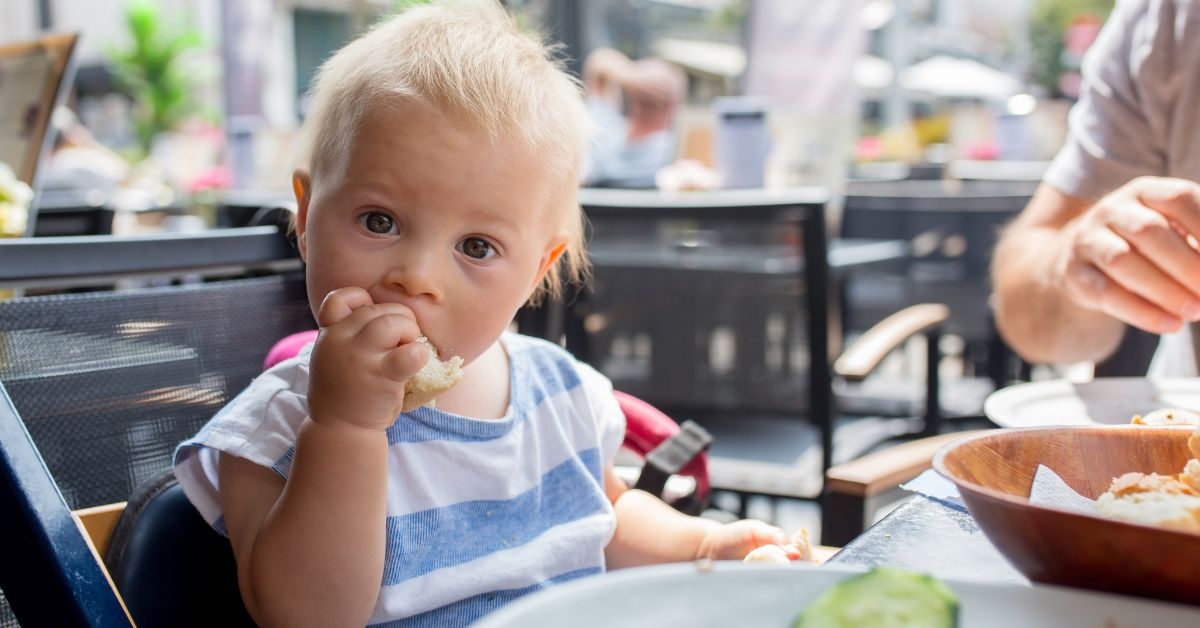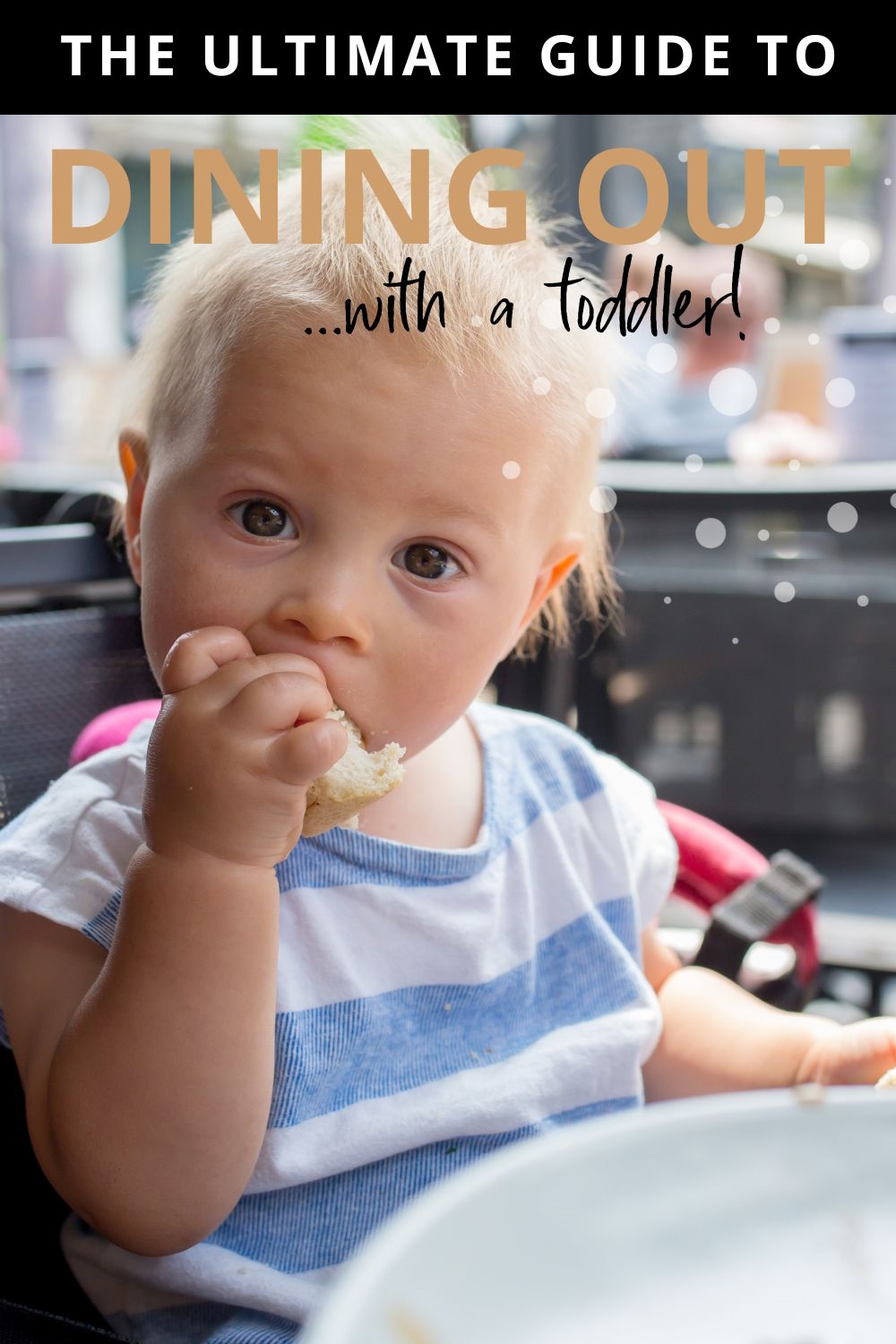When out in public, it is easy to start worrying about your kids offending others with their behavior. One of the places that can be the most stressful is restaurants! However, dining out with a toddler doesn’t have to mean flying food or nasty glares. It does most often mean leaving a mess under the table, though. 🙂 Nothing an extra tip can’t fix!
Here are my 21 tips for eating out with a toddler, including the planning of the event, what to bring to the restaurant, food tips, engaging activities, and a lot more.

Planning for Dining Out With A Toddler
1. Prepare Your Child by Play and Discussions
Depending on your child’s language development, you can talk to them about what it means to go to a restaurant, including the need to sit still or go on small excursions together with a parent, not shouting, that it may take a little time before the food arrives, and so on. But often, verbal instructions are less effective than play! Play eating out at home by “going out” with family members and dolls and practice what it means. And focus on getting them excited for the event, not nervous due to all the do’s and don’ts.
2. Prepare by Setting the Expectations at Home
A child who always receives immediate service at home won’t enjoy sitting at a restaurant table without food! Another way to prepare for future restaurant visits is to put your little one in her high chair while preparing dinner with a toy or a few snacks. She will then be used to waiting a little while for the main dish.
3. Choose A Family-Friendly Restaurant
A successful dining experience with your toddler starts with selecting the perfect restaurant and timing your visit strategically. You can set the stage for a successful outing by considering your toddler’s needs and preferences.
When choosing a restaurant, opt for establishments known to be family-friendly. These venues often have kid-friendly menus, high chairs or booster seats, and a welcoming atmosphere for young diners. Look for reviews or recommendations from other parents to find places that cater to families. A good playground or play corner can be like an answer to your prayers for a toddler or older child.
It may also be helpful if you have already visited the restaurant and know it is kid-friendly. And if they have your child’s favorite dish on the kids’ menu – even better!
I also find it helpful to visit restaurants with the “right” noise level – not too silent, not too loud.
4. Consider “Interesting Restaurants” (from a Toddler Perspective)
In addition to being family-friendly in general, some types of restaurants are more likely to be interesting for a toddler. For example, I visited a good really good Thai restaurant that was decorated as a rain-forest with my young kids. They loved it! So much to look at, and exciting sounds, lights, and even fishes.
I also visited a hamburger restaurant with some sort of motorcycling theme. My toddler was mighty impressed by the indoor motorcycle and all the other items and photos.
So, if possible, pick a restaurant that may be stimulating for your toddler.
5. Plan to Go On Off-Peak Hours
Timing is key when dining out with a toddler. Aim to visit the restaurant during off-peak hours to minimize wait times and avoid crowded spaces. Early dinners or late lunches can offer a more relaxed environment, allowing your toddler to explore without feeling overwhelmed by noise or distractions.
6. Plan to go when it best suits your toddler
Make sure you time the restaurant visit with your toddler’s schedule. It is not much fun to be at a restaurant with a toddler who had to skip a nap or should already be in bed.
There is one exception to this, though. If your toddler is used to sleeping in different places and is really likely to be able to fall asleep in the stroller even if you are at a restaurant, a late dinner is a possibility. I know it may seem crazy, but my oldest son was actually like that. When we spent three weeks on vacation and had to go out for dinner every night, we discovered that dinner at 6:30 p.m. was perfect. He ate and then fell asleep on two chairs that we put together under the table, and we could continue our meal while he slept. So, these kids do exist, but his two younger siblings were nothing like that so he might have been the rare exception! 🙂
7. Arrival before regular mealtime
Plan to arrive at the restaurant about half an hour before your regular mealtime. That gives you time to order and be served. We generally avoid places where you’d have to “wait to be seated”. Save those for date night!
8. Packing Essentials
Before heading out, assemble a well-equipped bag containing everything you might need to ensure your toddler’s comfort and well-being.
Include items such as:
- Diapers, Wipes, and Changing Mat: Keep an ample supply of diapers and wipes on hand, along with a portable changing mat for quick and hygienic diaper changes.
- Extra Clothes: Accidents happen, so packing an extra set of clothes for your toddler ensures that you’re prepared for unexpected spills or messes.
- Sippy Cup or Spill-Proof Water Bottle: Staying hydrated is crucial, and having a spill-proof cup can prevent spills and messes on the table.
- Other Eating Gear: You might consider bringing your toddler’s utensils if they have started using them!
- Your child’s own booster seat: For especially one of my children, it helped to bring their own booster that could be strapped onto a chair and buckled them in. It was a familiar spot, and our toddler didn’t put up a fuss. She’s always wiggled around in those wooden restaurant high chairs.
- Favorite Toy or Comfort Item: Bringing a beloved toy or comfort item can provide a source of familiarity and comfort for your toddler in a new environment.
- A Busy Bag: If you have a small bag of unfamiliar toys, you can keep pulling out new ones. I kept our busy bag in the closet. It only came out at a restaurant or when traveling, so the toys were like new.
- Additional items to keep your toddler busy: Check out the activity ideas below and what stuff you may want to bring to make those activities possible
- Snacks: Nothing brings a smile to a grumpy toddler’s face like a bag of their favorite snack food. Bring this out when you feel it is really needed (when you can feel a meltdown brewing)! Pack a small supply of your toddler’s favorite snacks in case they become hungry before the meal arrives. Having a familiar snack on hand can help keep your child content and prevent fussiness.
- Emergency Supplies: Consider carrying a small pouch of essentials like adhesive bandages, tissues, and hand sanitizer for any unexpected situations.
At the Restaurant
9. Where to sit
Sometimes you can choose where to sit in the restaurant. To reduce your own stress, consider sitting somewhere where a talkative, sometimes protesting toddler will not disturb other dinner guests. A booth can be great, or sitting outside or in a corner.
10. Be Quick When Ordering The Food
Decide quickly and order quickly. Go directly for main courses (and order desserts later if everything goes well). An appetizer usually delays your main course. Those are precious minutes! If you do get an appetizer, order something your toddler will enjoy, too!
11. Pay when you order
A smart way to reduce the waiting time when your toddler really has had enough of the dining out experience is to pay the check already when you order the food, or at least when the food arrives, at the latest.
12. What foods to choose for your toddler
One of the keys to a successful restaurant outing with a toddler is selecting foods that cater to their taste preferences and developmental stage.
Since toddlers can be pretty picky with their foods, let them take part in deciding what to eat. Also, double-check with the waiter what exactly will be served if you order a particular dish. For example, the sprinkled parsley on the spaghetti or the tomato slice on the hamburger can completely destroy a toddler’s willingness to try the food. Ask the waiter to remove anything that you can forsee that your child will not like. This is not the time to press your toddler to try new things or fret over a not-perfectly-healthy food choice by your toddler.
13. Tips on Foods Many Restaurants Can Prepare Even If They’re Not On The Menu
While the best thing to do is to check the menu before deciding on a restaurant, there may be times when we still end up in a restaurant and realize that the food choices your toddler will appreciate are limited.
In such a case, here are some ideas on what to ask if the restaurant can fix even if the dishes are not included on the menu:
- Chicken Tenders or Nuggets: Bite-sized, mildly flavored chicken pieces or nuggets are often a hit with toddlers due to their familiar taste and easy-to-eat nature.
- Boiled Pasta or Rice: Literally any pasta or cooked white rice, with butter and possibly cheese or cream, will be accepted by most toddlers.
- Grilled Cheese Sandwich: The gooey cheese and soft bread of a grilled cheese sandwich make it a simple yet satisfying choice for young diners.
- Fresh Fruit Slices or Cups: Many restaurants offer fruit sides or cups, providing a refreshing and nutritious option for your toddler.
- Steamed Vegetables: Steamed vegetables that you know your toddler appreciates are good options, such as broccoli, corn, or peas, which are easy for little fingers to grasp.
- Pizzas with Simple Toppings: Introduce your toddler to new flavors by offering mini pizzas with basic toppings like cheese, ham, or diced vegetables.
- Finger Foods Platter: Some restaurants can fix platters with an assortment of finger foods such as mini sandwiches, cheese cubes, pieces of fruits or vegetables, and crackers, allowing your toddler to enjoy a variety of flavors and textures (preferably of foods they already like).
14. Keep Your Toddler Engaged
Engaging your toddler during the restaurant experience is key to maintaining their interest and ensuring a pleasant mealtime. Here are some ideas on fun activities that work in most restaurants:
i) Quiet Activities and Games
Coloring Books and Crayons
Provide coloring books and crayons to keep your toddler engaged and creative while waiting for the food to arrive.
Puzzles and Simple Games
Bring along small puzzles or simple games that your toddler can enjoy at the table, enhancing their cognitive skills.
Fun toys from the Busy Bag
If you brought a busy bag (see above), bring out one toy at a time for your toddler to play with.
ii) Interactive Play
Seated scavenger hunt
Play a game where you encourage your toddler to observe their surroundings and identify objects of interest. Of course, walking around for a simple scavenger hunt can work well, too, depending on the restaurant.
Storytelling and Finger Puppets
Create stories using napkins and utensils, or bring along finger puppets to spark your toddler’s imagination.
iii) Breaks and Movement
Short Walks or Restroom Visits
Allow your toddler brief breaks to stand up, walk around, or visit the restroom. This movement can help them release energy and reduce restlessness. We always used the restroom after placing our order. That seems to be the time when little ones get the most restless. It also avoids the “I have to go potty!” as you take your first bite!
Change of Scenery Outside the Restaurant
If your toddler becomes particularly restless, take a short walk outside the restaurant to provide a change of scenery before returning to the table.
15. Manage Restlessness and Behavior


Remember that no matter how hard you try, it is very possible that your toddler will become restless, tired, or grumpy. If this happens, verbal correction is not the best way forward; it will only make all of you even more stressed and grumpy! Instead, mitigate the restlessness through positive reinforcement, distraction, or redirection. These are strategies that work best with toddlers.
So, what can positive reinforcement, distraction, and redirection look like in a restaurant setting? In addition to simply switching between the different activities suggested above, you can try the following:
i) Positive Interaction and Reinforcement
Engage in Conversation
Initiate discussions with your toddler about the restaurant, the food, or their day. Engaging them in conversation can create a sense of involvement and make the experience more enjoyable.
Create Restaurant-Themed Stories
Craft stories about the restaurant’s surroundings or the food being served, involving your toddler in imaginative storytelling.
Praise and Encouragement
Offer genuine praise for your toddler’s good behavior, such as using utensils correctly or staying seated. Positive reinforcement can motivate them to continue exhibiting appropriate behavior.
Small Rewards
Consider introducing small rewards, like a favorite sticker or a piece of fruit, to reinforce positive actions, such as staying in the seat for ten more minutes, and create a positive association with dining out.
ii) Distraction and Redirection Techniques
Offer Small Snacks or Finger Foods
Provide small, healthy snacks or finger foods to keep your toddler occupied while waiting for the main meal.
Change of Focus
Gently redirect your toddler’s attention if they become fixated on an undesired behavior. Offer a completely different activity or point out something interesting in the surroundings.
Technology
A smartphone or tablet with age-appropriate apps or games can serve as a distraction when needed. This may be good to save for last when your toddler is tired or restless and needs a fun break while you have a chance to finish your meals.
16. Manage your own expectations and manners
In addition to your toddler becoming grumpy and restless, managing your own temper if things don’t go exactly as planned may be just as important for a successful dining out with a toddler. If you get irritated, your toddler will likely sense your negativity, and the situation can spiral out of control.
Here are some things to consider:
i) Setting Realistic Expectations
Setting realistic expectations is crucial when dining out with a toddler. You can’t expect a toddler to sit nicely and “behave”. Developmentally, toddlers naturally have limited attention spans and may become easily distracted or restless. Expecting them to sit still for an extended period may be unrealistic. In addition, toddlers are curious and energetic. This is why engaging with them is so important.
ii) Flexibility and Adaptability
Dining out with a toddler is to take a chance. If it goes really well (everyone is happy and the food is actually eaten, at least by the adults), consider yourself a lottery winner. The difference compared to a lottery is, however, that you do have a good chance to affect the outcome. Keep in mind that being patient, adapting to how things evolve, and focusing on enjoying the situation rather than demanding everything to be perfect will make a true difference.
Be Patient
Understand that your toddler’s behavior might vary from day to day. Maintain a patient and calm demeanor, even in the face of restlessness.
Go with the Flow
Embrace the unpredictability of dining out with a toddler. Always be prepared to adapt your strategies and plans based on your child’s mood and needs.
Focus on Quality Time
While the primary goal is to enjoy a meal, remember that dining out with your toddler is also a chance to bond and create positive memories together.
When and How to Leave The Restaurant
17. Reading Your Toddler’s Cues
Pay attention to your toddler’s signals. If they’re becoming overly fussy, agitated, or restless, it may be a sign that they’ve reached their limit.
18. Making a Swift Exit
Trust your instincts as a parent. If the situation becomes overwhelming or uncomfortable for your toddler, don’t hesitate to conclude the meal and leave the restaurant gracefully. If you paid when you ordered the food, it will be a lot easier to leave quickly.
19. Thank the Staff and Tip Well
Whether or not you leave quickly or calmly, remember to thank and tip the waiters. Your party probably made some sort of mess and possibly some noise. That’s natural for a family, but it is still fair to acknowledge the restaurant staff for their help and patience.
After the Restaurant Visit
20. Dining Out as A Learning Experience
Every Outing is a Lesson: Each restaurant outing with your toddler provides growth and learning opportunities – for all of you! Reflect on the experience afterward to identify what worked well and what could be improved for future outings.
21. Celebrate Small Wins
Focus on what worked: Celebrate even the smallest successes, such as your toddler trying a new food or demonstrating improved table manners. Positive reinforcement encourages continued progress.
Conclusion
Eating out with your toddler can initially seem daunting, but it can be a fun and memorable event with the right strategies and a positive mindset. With proper planning, choice of restaurant and food, and several fun activities up your sleeve to keep your toddler engaged and happy, there is a good chance for a great dinner. And if not… be prepared to leave quickly and without disappointment. Hey, at least you tried! And next time, it will be easier!
What are your best tips for dining out with a toddler?
Read Next


Paula Dennholt founded Easy Baby Life in 2006 and has been a passionate parenting and pregnancy writer since then. Her parenting approach and writing are based on studies in cognitive-behavioral models and therapy for children and her experience as a mother and stepmother. Life as a parent has convinced her of how crucial it is to put relationships before rules. She strongly believes in positive parenting and a science-based approach.
Paula cooperates with a team of pediatricians who assist in reviewing and writing articles.
Trending Products












